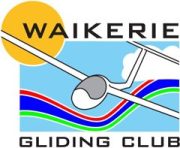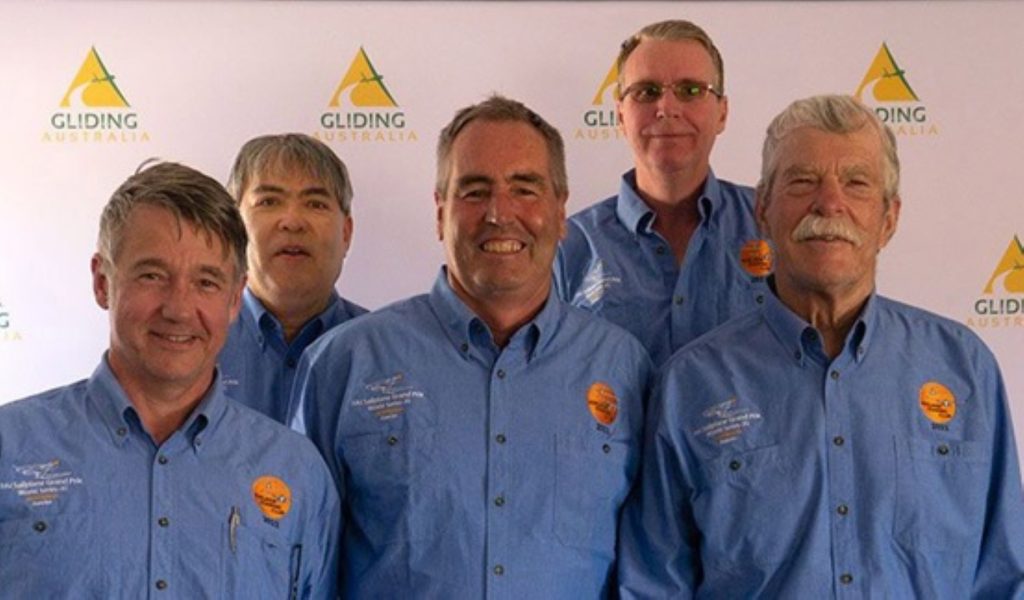Firstly a brief resume on the International GP. About a decade or so ago, a British glider pilot and previous 15m Class World Champion (Benalla) Brian Spreckley decided there needed to be an alternative to the classical format for glider racing. The GP was born. The idea was to create a race that had spectator appeal and would attract sponsorship from advertisers. Using the F1 motor racing as a sort of template the idea was that there would be a racehorse style start, through a narrow and lowish window so spectators could easily se the start and then fly a 2-3 hour race with a low finish and the first home being the winner. Live tracking and commentary are provided over the Internet. A simple points system was devised with the first few pilots getting points and the remainder nil! Ah la F1 motor sport scoring. At the international level a strict set of rules for running the competition are in place governing start conditions, aircraft wingloading etc. Each year a total of around 10 elimination rounds are held in a range of locations in Europe, Chile and South Africa. The winners are then invited to the GP final, with the next final to be held at Pavullo in Italy late August this year.
Although the spectator appeal and sponsorship has not really materialised, this format has proven very popular with pilots. What has happened is that ‘spectators’ follow the races live with running commentary. This has been hugely popular. Many local competitions now use the GP format, modified to suit local circumstances in an attempt to attract maximum participation. In the past the immensely popular annual Skyrace GP held at Leeton during summer is an example. (Skyrace GP promises to be back again next year.) The last and next South Australian state championships are also GP style.
Back to Gawler
As we all know, over the last couple of summers, gliding had been plagued by the COVID situation and the control measures put in place. However, when it started to look like we were going be able to live with COVID, inflation was still low and a reasonable level of gliding activity was expected the GP at Gawler had about 20 entries, with a couple from overseas. Sadly as COVID lingered, and inflation took off, the number of entries began to dwindle and we ended up with 5 entrants. Clubs represented were Lake Keepit, Temora, Canberra, Adelaide and myself from Waikerie. Craig Vinyl had entered but made the noble decision to withdraw in order to concentrate on preparing for the Nationals at Waikerie which started just two days after the GP finished. From those of us that attended the Nationals, thank you Craig for your sense of responsibility and preparatory work.

We had a bit of excitement just before the contest when I received an evening phone call from Geoff Brown who was stuck on the side of the road near Blanchetown with the wheels of his trailer having partially detached from the frame. A late night rescue, putting his glider in my trailer and his trailer on a rescue truck still ended up with having his glider rigged the next day a Gawler. Lucky the failure didn’t occur on the Hay Plain!!
Now, as we know, these competitions don’t just happen! In the case of the FAI GP there are a bunch of strict hoops that the organisers have to jump through in order for it to gain accreditation as a qualifying event, with the work starting at least a year in advance. I would therefore like to acknowledge the outstanding work that Mandy Temple (Contest Director) did to bring this thing off, particularly as the list of entrants slowly dwindled. I understand that there had been talk of running it outside of the International environment due to the low numbers, but Mandy stuck with it and we ended up with a great event. Thank you Mandy.
The format of the each day is fixed by the international rules. The task is set at which a maximum start height and maximum ground speed through the start is nominated. Maximum height is generally somewhat below the top of the expected convection level and the maximum ground speed is usually 170kph
Pilots are launched and race start time via a count down is controlled by radio from the ground. At the 20 minute call, pilots start to position themselves for the start and at subsequent time markers pilots have to be positioned in accordance with the rules which are set to reduce potential conflict in the start area.
Once the start gate is open pilots are free to start. Errors in pre-start manoeuvring, starting early, excess speed or height at start are all penalised by adding time to your finish time. Once started generally most competitors end up working the first thermal together at the same height.
Gotta be careful here! The international rules are strict and it’s easy to err. With the small numbers at Gawler it was relatively easy, but with the maximum number of gliders at an International GP being 20 this is a challenging and carries risk. The manoeuvring before start can be quite dynamic and often the first climb starts from quite low – a mid-air would be disastrous. This is the only bit of the GP format that I really don’t like. Increasing the start gate width (not possible at Gawler due airspace) and increasing the start height would make a significant difference. Of course the strict constraints only apply to the international even and for domestic GPs local rules can be set as desired and risks reduced.
Notwithstanding the lack of congestion at Gawler, many of us managed to crowd ourselves at the start and most of us got small penalties for being slightly fast or slightly high!
I won’t describe the races blow by blow, rather to say that the tasking and gate opening was really first class. Using Skysight and local knowledge Peter Temple produced excellent tasks and on each day Mandy opened the gate at what proved to be the right time for the extant conditions.
The racing was great fun, there was no start gate shenanigans with pilots trying to start just behind a fellow competitor to run him down, the gliders performed more or less similarly due to the common wingloading, the person out the front was winning and because of modern tracking technology, particularly Flarm, pilots could see who was ahead giving extra incentive to do better!
The first few days were in quite low blue conditions with heights slowly improving during the week. One of the joys of the International GP format is that glider performances are to an extent equalised by all flying at the same maximum wingloading (at Gawler 48Kg/SqM) so we tended to race around in a loose pack, much of the time within about 10-15 km of each other. When low, say below 2000ft agl, it made it a little less uncomfortable if there was someone else sampling another piece of the sky nearby. On the first couple of days I along with the others spent quite a bit of time below 2,000ft agl!! In fact looking at my logs, on day one I climbed from at or below 2,000ft agl 9 times including at or below 1500ft agl 3 times and on day two from below 1500ft agl twice. After the first 4 days I had been below 2,000ft agl about 18 times, including below 1500ft agl about 8 times!! Most of the time in the vicinity of other competitors.
On day two I managed to exceed the contest area height by 28ft for a few seconds and was out landed at that point. Mac was only 11 ft high for a couple of seconds, but ‘rules is rules’ and we both got zero points for the day. We had both been running an energy line north out of Gawler and despite monitoring altitude I didn’t push forward hard enough during an upwards push to stay inside the contest area. Silly old me.
The weather steadily improved with the last two being very fast under high based cumulus. Race speeds steadily increased from about 100kph on the first two days to around 150kph on the last two days.
Sean Young, editor of Gliding Australia, was at the event conducting the interviews, populating the GP website and along with Mandy provided the live commentary. For those that are interested and wish to see the fruits of Sean’s labour, the videos, interviews, live coverage and scores are at https://australia23.sgp.aero . Just work through the ribbon near the top of the page. Well worth a look. .
From the results it will Pete Temple who will be invited to participate in Italy later this year.
To summarise.
The tasking and execution by Team Temple was first rate, the weather whilst challenging on the first couple of days, gave us a great range of conditions and the flying was great fun. The camaraderie between pilots and the very small band of officials, tug pilots and helpers was a delight. Many thanks to that small band of folks who simply came most days, just to help. You know who you are. You were much appreciated. Thank you, thank you.
Finally, I can thoroughly recommend flying GP style races if you have the opportunity. The SA state comps are on in a couple of weeks, in the GP style format. Give it a go!
David Pietsch


